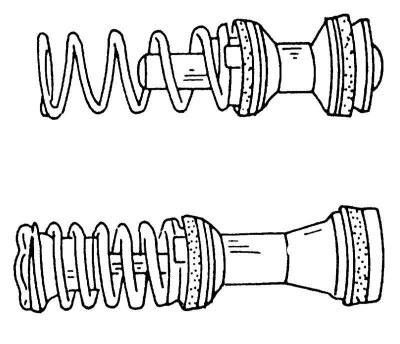Removal and installation

Wiring diagram of the main brake cylinder. The bottom right shows the cylinder in the case of ABS installed
1 - cover; 2 - compensation tank; 3 - rubber nozzle; 4 - nut; 1.6 l = 10-15 Nm; 2.0 l = 11-17 Nm; 2.0 l = 8-11 Nm (with ABS); 5 - intermediate piston; 6 - pressure piston; 7 - rubber seal; 8 - intermediate washer; 9 - persistent cap; 10 - piston cuff; 11 - spring cup; 12 - return spring; 13 - cylinder body; 14 - cylinder body gasket
1. Disconnect the cable from the brake fluid level indicator.
2. Unscrew both brake pipelines from the cylinder. Plug the ends of the pipelines.
3. Loosen the brake master cylinder from the end surface of the brake booster and carefully remove the cylinder without splashing brake fluid on the varnish surfaces. Installation of the cylinder is carried out in the reverse order of removal. After installation, bleed the brake system (Chapter Bleeding the brakes).
Repair of the main brake cylinder
First, determine the manufacturer of the cylinder. Cylinders from different manufacturers can be installed on Nissan. Elements of different designs cannot replace each other. If an ABS system is installed, another cylinder is installed. The illustration shows both versions of the brake master cylinder.
1. Remove cover (1) and drain the liquid.
2. Clamp the cylinder in a vise.
3. Use a screwdriver to remove the piston stop cap (9) from the cylinder body. On a cylinder without ABS, bend the two locking tabs from the inside of the flange inwards; on an ABS cylinder, fold out the locking tabs from the outside. Then remove the cap.
4. Pull out the pressure piston (6). It is possible to use compressed air. Connect compressed air to the brake hose connector. Wrap the cylinder well with a rag so that the piston does not fly far.
5. Check the cap immediately. If one of the locking tabs is damaged, a new cap must be installed.
6. Remove the cuffs from the piston with your fingers.
7. If further disassembly is required, carefully wring out the expansion tank (2) from the cylinder with a screwdriver. Take out the rubber nozzle (3) (always replace).
8. The pressure piston is not disassembled. Clean all parts with brake fluid or alcohol. If the cylinder bore or piston looks satisfactory, measure the bore diameter and piston outer diameter with a micrometer. The difference between the values should not exceed 0.15 mm.
9. Dip the piston cups into the brake fluid and install on the piston.
10. At the same time, follow the installation direction of the cuffs (see illustration below). Reassemble the cylinder according to the wiring diagram. When installing the piston, press both parts into the hole with a screwdriver and install the thrust cap. With ABS installed, push the cams inward; without ABS, push the cams outward. Check that the cap is securely seated on the case.

Correct assembly of the intermediate piston (up) and pressure piston (at the bottom).